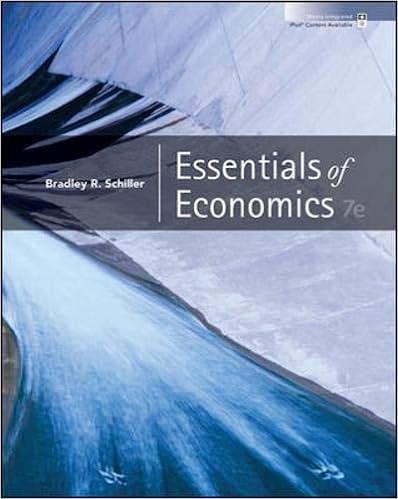Question
1.How are a typical monopolistically competitive firm and a typical perfectly competitive firm alike? Select one: a. Both achieve productive efficiency only. b. Both achieve
1.How are a typical monopolistically competitive firm and a typical perfectly competitive firm alike?
Select one:
a. Both achieve productive efficiency only.
b. Both achieve allocative efficiency only.
c. Both achieve allocative and productive efficiency.
d. Both experience zero economic profits in the long run.
e.Both face perfectly elastic demand.
2.All of the following except one are true statements about the MRP. Which is the exception?
Select one:
a.It is equal to change in TP/price.
b.It is equal to MPL x price.
c.It is equal to change in TR/ change in inputs
d. It is the increase in total revenue that results from the use of one more unit of input.
3.Why is it difficult for colluding firms to maintain a cartel?
Select one:
a. Because cartels are illegal.
b. Because cartels always end up producing too little with the result that at least one member firm will find it profitable to raise its price and the other firms will follow.
c. Because the large profits made by existing firms result in new firms entering the industry.
d. Because member firms find the prospect of cheating too attractive to resist.
4.If a firm is operating in a monopsony market, which of the following statements is correct?
Select one:
a. The firm can hire additional labour at the same wage rate it is currently paying.
b. The MPRL declines faster in the case of the monopsony situation than in the competitive one.
c.The firm faces an upward-sloping supply of labour curve.
d. The firm would hire more labour in the monopsony situation than in the competitive situation.
e. The firm's demand for labour curve is downward-sloping in the situation of the monopsony market and horizontal in the case of the competitive one.
5.Why is it impossible for a monopolistically competitive firm to achieve productive efficiency?
Select one:
a. All monopolistically competitive firms make economic profits.
b. The market demand curve is perfectly elastic.
c. The firm's demand curve is not perfectly elastic.
d. The firm's marginal cost curve is upward sloping.
e. All monopolistically competitive firms are too small.
6.When is a monopolist's total revenue at a maximum?
Select one:
a. When it is equal to its average revenue.
b. When its marginal revenue is at a maximum.
c. When its average revenue is equal to its marginal revenue.
d. When its marginal revenue is equal to zero.
e. When it is equal to its marginal cost.
7.Zero economic profit means there is no profit in this business
Select one:
True
False
8.Which of the following statements regarding a monopolist is correct?
Select one:
a. A monopolist will only produce an output where the demand is inelastic.
b. A monopolist will only produce an output where the demand is perfectly elastic.
c. A monopolist will only produce an output where the demand is elastic.
d.A monopolist will only produce an output where the demand is unitary elastic.
9.An employer operating under conditions of a perfectly competitive labour market will hire labour up to the point where the marginal product of labour equals the wage rate.
Select one:
True
False
10.If the demand for a product is elastic, then total revenue will:
Select one:
a. rise as price falls.
b. increase whether price increases or decreases.
c. be constant in response to a price change.
d. fall as price falls.
Step by Step Solution
There are 3 Steps involved in it
Step: 1

Get Instant Access to Expert-Tailored Solutions
See step-by-step solutions with expert insights and AI powered tools for academic success
Step: 2

Step: 3

Ace Your Homework with AI
Get the answers you need in no time with our AI-driven, step-by-step assistance
Get Started


